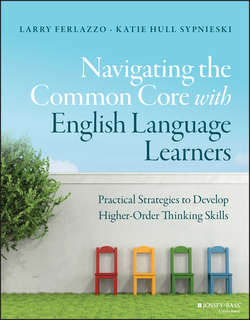Читать книгу Navigating the Common Core with English Language Learners - Sypnieski Katie - Страница 13
На сайте Литреса книга снята с продажи.
Chapter One
English Language Learners and the Common Core: An Overview
ELL Research Basics
ОглавлениеJust as the number of ELLs has continued to grow, so does the research base on how ELLs acquire language and how this affects instructional practices and policy. While we will cite current ELL research throughout this book, in this section, we will first highlight a few foundational concepts of language development research.
BICS and CALP
Jim Cummins, a professor at the University of Toronto, first introduced the distinction between BICS (basic interpersonal communicative skills) and CALP (cognitive academic language proficiency). His research has had a major impact on policy and practices in second language education.33 Table 1.1 summarizes Cummins's distinctions.
Table 1.1 BICS and CALP
In more recent research, CALP has been expanded to include three dimensions of academic English: Linguistic (knowledge of word forms, functions, grammatical elements, and discourse patterns used in academic settings), Cognitive (higher-order thinking involved in academic settings), and Sociocultural-psychological (knowledge of social practices involved in academic settings).34
Instruction based on CALP is still widely accepted as best practice. Many researchers agree upon the need to focus on academic language proficiency in order for ELLs to be successful in school.
Acquisition versus Learning
There is general agreement among researchers that there is a distinction between acquiring a language and learning a language.35 Acquisition involves being able to easily and naturally use the language to communicate in a variety of situations, both academic and social. Language learning requires a more conscious approach and might include being able to correctly complete a grammar worksheet. However, this does not mean the two are mutually exclusive.
Much debate over the place of explicit grammar study has occurred throughout the years. Recent research points to a balanced approach – that second language instruction can provide a combination of both explicit teaching of language features such as grammar, vocabulary, and pronunciation, and implicit learning stemming from meaningful communication in the second language.36
This type of language instruction – using meaningful input and contexts to help students develop proficiency while also teaching specific language features and functions in context – is critical in helping ELLs meet the Common Core standards.
English Language Proficiency Levels
Researchers agree that ELLs progress through general stages of language acquisition. These stages have traditionally been divided into five levels of English proficiency: Beginning, Early Intermediate, Intermediate, Early Advanced, and Advanced. More recently, consortiums made up of states and organizations, who are working on new ELD standards and assessments aligned to Common Core, use different descriptors for each level. We will be discussing these groups and their work later in this chapter.
Table 1.2 illustrates how these different proficiency level labels correspond. In this book, we will use Beginning–Advanced because that is how our school district classifies ELL students.
Table 1.2 English Proficiency Level “Labels”
Of course, students' language acquisition often doesn't progress in a linear fashion within and across these proficiency levels. Students may demonstrate higher levels of proficiency in one domain versus another (e.g., listening versus writing) and may demonstrate different levels of proficiency within a domain depending upon the task. It is important to remember that a label of “Level 1” or “Beginner” doesn't identify the student, but identifies what a student knows and can do at any stage of English Language Development.
33
Cummins, J. (1999). BICS and CALP: Clarifying the distinction. Educational Resources Information Clearinghouse No. ED438551. Retrieved from http://files.eric.ed.gov/fulltext/ED438551.pdf
34
Scarcella, R. (2003, April). Academic English: A conceptual framework. University of California Linguistic Minority Research Institute. Retrieved from http://escholarship.org/uc/item/6pd082d4#page-1
35
Krashen, S. D. (1982). Principles and practice in second language acquisition (p. 10). Oxford, UK: Pergamon Press. Retrieved from http://www.sdkrashen.com/content/books/principles_and_practice.pdf
36
Goldenberg, C. (2008, Summer). Teaching English language learners: What the research does – and does not – say. American Educator. Retrieved from http://homepages.ucalgary.ca/∼hroessin/documents/Goldenberg,_2008,_America_Ed_Summary_of_research.pdf
